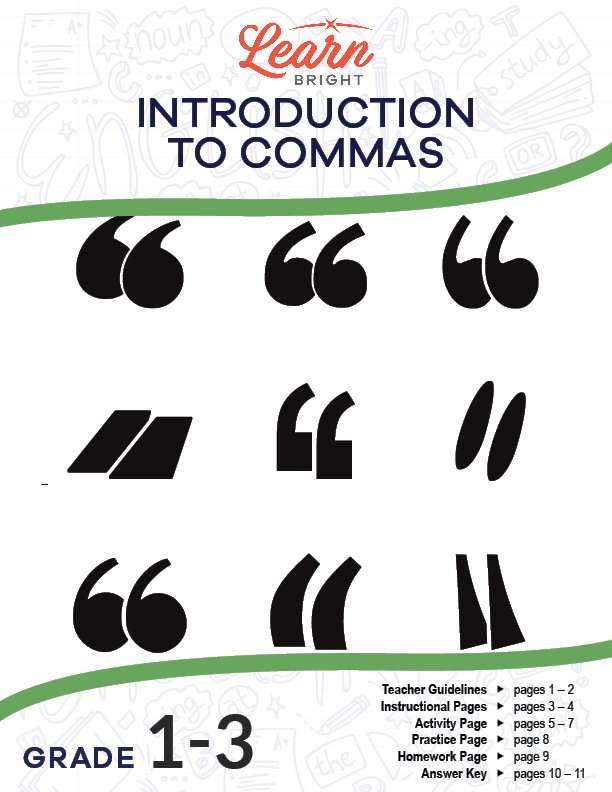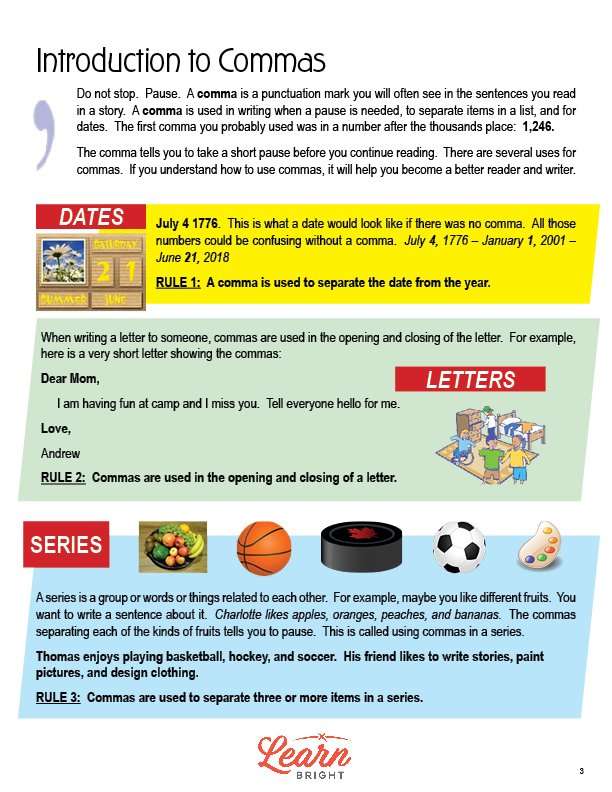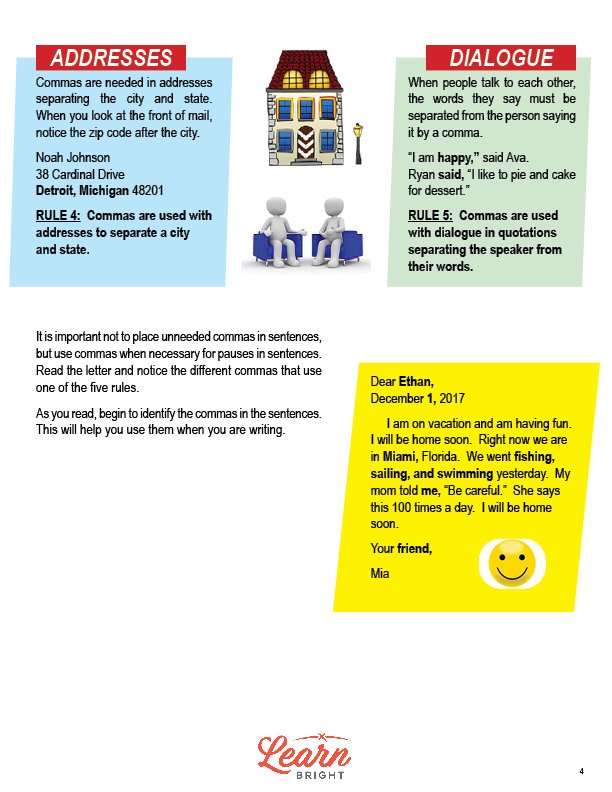Description
What our Introduction to Commas lesson plan includes
Lesson Objectives and Overview: Introduction to Commas introduces students to the proper use of commas in writing. They learn how to use commas in a variety of contexts and for a variety of purposes, as well as when not to use commas. At the end of the lesson, students will be able to define comma, and correctly use commas in dates, series, greetings, letter closings, addresses, and dialogue. This lesson is for students in 1st grade, 2nd grade, and 3rd grade.
Classroom Procedure
Every lesson plan provides you with a classroom procedure page that outlines a step-by-step guide to follow. You do not have to follow the guide exactly. The guide helps you organize the lesson and details when to hand out worksheets. It also lists information in the green box that you might find useful. You will find the lesson objectives, state standards, and number of class sessions the lesson should take to complete in this area. In addition, it describes the supplies you will need as well as what and how you need to prepare beforehand. The supplies you will need for this lesson are scissors and the handouts. To prepare for this lesson ahead of time, you can gather the supplies and copy the handouts.
Options for Lesson
Included with this lesson is an “Options for Lesson” section that lists a number of suggestions for activities to add to the lesson or substitutions for the ones already in the lesson. One optional addition to the activity worksheet is to simply use additional words to extend the activity. You can also refer to current reading in other subjects to show students how they use commas. Another optional addition is to write a paragraph with many unnecessary commas and have students correct it. Finally, you can have your students find commas that follow the five comma rules introduced in this lesson in your local newspaper or a magazine.
Teacher Notes
The teacher notes page includes a paragraph with additional guidelines and things to think about as you begin to plan your lesson. This page also includes lines that you can use to add your own notes as you’re preparing for this lesson.
INTRODUCTION TO COMMAS LESSON PLAN CONTENT PAGES
The Introduction to Commas lesson plan includes two pages of content. The lesson begins by explaining that commas mean that you should pause instead of stop. Commas are very common punctuation marks. They’re used when you need to pause, if you want to separate items in a list, and when writing dates. One of the most common uses for commas is in numbers over 999. Usually, when you see a comma, it means that you should take a short pause. Understanding when and how to use commas will make you a better reader and a better writer! The lesson outlines five different comma rules that you should follow.
Five Comma Rules
The first rule is that we use a comma to separate the date from the year. For example, you would write July 4, 1776 instead of July 4 1776. Adding a comma makes the date easier to read. The second rule is that we use commas in the opening and closing of a letter. The lesson includes a helpful example of this. The third rule is that we use commas to separate three or more items in a series. A series is a group of related things. For example, if you were listing fruits, you would write: Apples, bananas, and oranges. This makes the list easier to read and tells you to pause in between each item.
The fourth rule is that we use commas with addresses to separate cities and states. For example, you would write Detroit, Michigan instead of Detroit Michigan. You should not include a comma after the state and before the zip code. This is another rule that makes your writing easier to understand! The fifth rule is that we use commas with dialogue in quotations to separate the speaker from their words. The lesson includes several examples of this rule as well.
It is also important to not use too many commas or unnecessary commas. The lesson closes with an a short example letter that includes all of the needed commas in bold letters.
INTRODUCTION TO COMMAS LESSON PLAN WORKSHEETS
The Introduction to Commas lesson plan includes three worksheets: an activity worksheet, a practice worksheet, and a homework assignment. You can refer to the guide on the classroom procedure page to determine when to hand out each worksheet.
CUT OUT ACTIVITY WORKSHEET
Students will work together with a partner to complete the activity worksheet. Each pair will first cut out the provided words, numbers, commas, and periods. They will then join them together to make sentences, writing each complete sentence on the lines on the worksheet. Each pair will create as many sentences as they can! Each sentence must have at least one comma, and each will end with a period.
Students can also work either alone or in larger groups for this activity.
COMMAS AND COMMA RULES PRACTICE WORKSHEET
For the practice worksheet, students will complete two short exercises. The first asks them to add commas where they’re needed in 10 different sentences. The second asks them to look at examples of comma usage and identify the comma rule being used for each.
INTRODUCTION TO COMMAS HOMEWORK ASSIGNMENT
The homework assignment is split into two sections. For the first section, students will write sentences with commas using each comma rule. For the second section, students will add commas where needed in a letter.
Worksheet Answer Keys
This lesson plan includes answer keys for the practice worksheet and the homework assignment. If you choose to administer the lesson pages to your students via PDF, you will need to save a new file that omits these pages. Otherwise, you can simply print out the applicable pages and keep these as reference for yourself when grading assignments.









